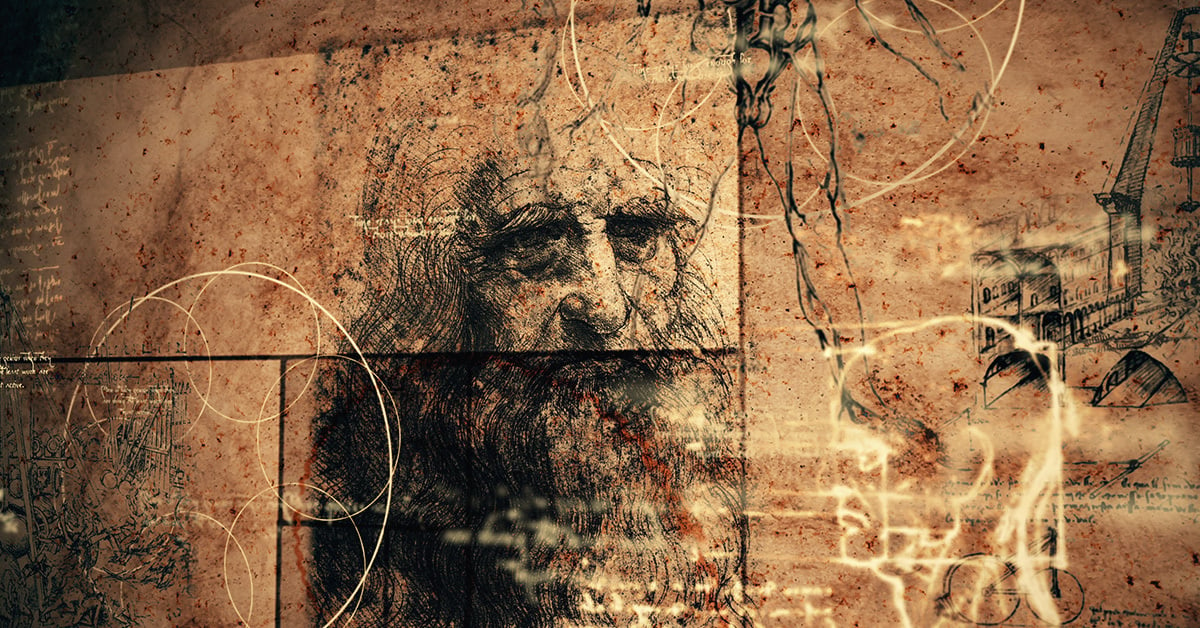Few names in the art world are as universally recognised as Leonardo da Vinci. A true ‘Renaissance man’, da Vinci’s genius encompassed everything from painting and sculpture to anatomy and engineering.
But it’s his mastery of art that we want to shine a spotlight on today. Inspiring generations of artists with his iconic paintings and sketches, it’s safe to say that da Vinci’s ‘doodles’ left their mark on history.
So, whether you’re an art aficionado or are just starting to explore the world of fine art, join us as we run through 10 of da Vinci’s most influential pieces, exploring why he remains a towering figure in the art world centuries after his time.
10. Madonna and the Child (c. 1490)
Up first, we have Madonna and the Child, also often referred to as Madonna Litta.
This devotional image, part of a tradition of ‘Madonna lactans’, is one of da Vinci’s most famous religious paintings alongside the Last Supper and Salvator Mundi (you’ll meet those shortly).
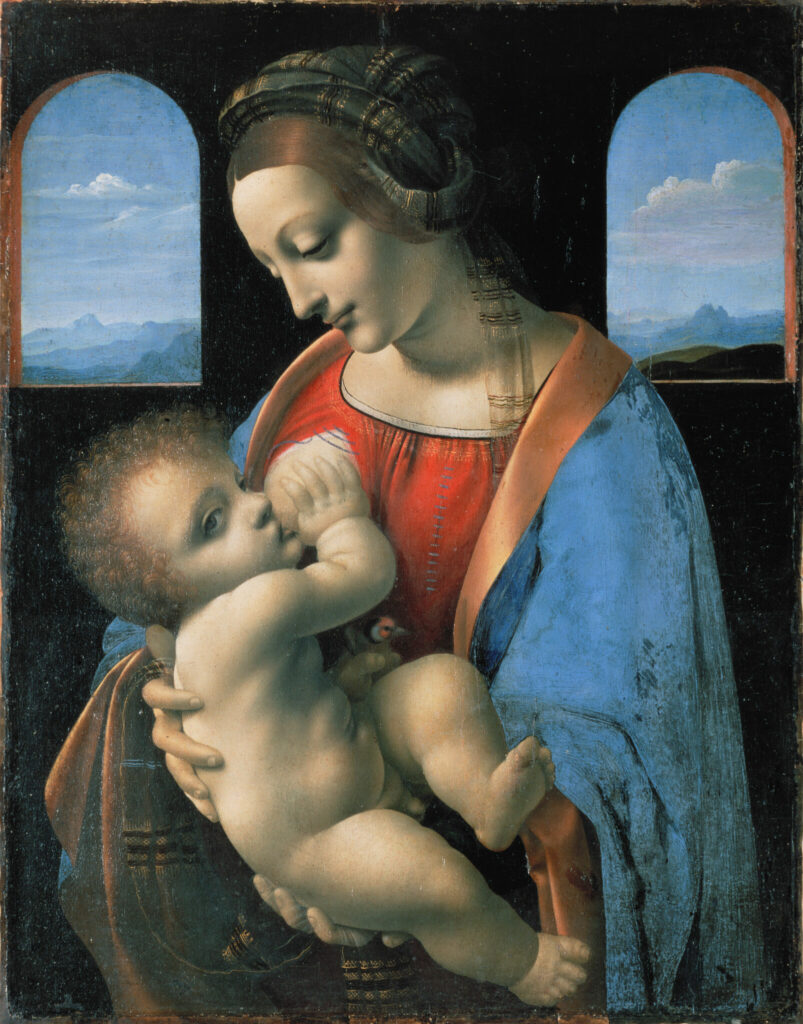
By Attributed to Leonardo da Vinci – Hermitage Torrent(.torrent with info-hash), Public Domain, https://commons.wikimedia.org/w/index.php?curid=59760
Aside from its powerful depiction of Christ as an infant, this painting is praised by art fans everywhere for its symbolism. If you look closely, you’ll see a tiny goldfinch in the infant’s hand, a symbol closely associated with the Crucifixion on account of the bird’s red spot. Tiny messages included throughout the painting by da Vinci extend the influence of this picture through foreshadowing and metaphor, making it a gift for art students everywhere!
9. Ginevra de’ Benci (c. 1474/78)
Weighing in at number nine, we have one of da Vinci’s earliest known paintings and, notably, the only one of his paintings on display to the public in the Western Hemisphere! Currently on show in the National Gallery of Art in Washington, D.C., this painting was completed by da Vinci when he was in his early twenties and is considered highly experimental.

By Leonardo da Vinci – 9QEdQ-BD4WEqPQ — Google Arts & Culture, Public Domain, https://commons.wikimedia.org/w/index.php?curid=21979801
Note the position of the woman in the painting: she is in a three-quarter position rather than a straight-on profile, making her the first example of this style by an Italian painter. This humble lady laid the foundation for the likes of the Mona Lisa (more on her later) and indeed portraiture itself.
Another interesting detail found in this portrait is fingerprints, suggesting that da Vinci actually used his fingers to model her face before the paint hardened in yet another innovative technique.
When it comes to da Vinci’s oeuvre, then, consider this an early cornerstone.
8. Salvator Mundi (c. 1500)
Would you pay millions for a painting if you weren’t 100% sure it was by the artist you thought it was?
On this list so far, we haven’t discussed money, but when it comes to art and influence, price is a factor that can weigh heavily. This portrait of Jesus holding a glass globe is famed for its iconography and symbolism. Salvator Mundi, or the ‘Saviour of the World’, is not only influential for what it depicts but has enjoyed renewed influence in recent years due to its famous sale.

Leonardo da Vinci – [1], Public domain, https://commons.wikimedia.org/w/index.php?curid=15771821
In 2017, this painting sold for a staggering $450.3 million — breaking both art sales records and the bank. This sale was even despite the fact that the painting was in poor condition and had a questionable attribution to da Vinci, though Christie’s Auction House dismissed this criticism.
7. The Virgin of the Rocks (c. 1483- 86)
Sticking with the religious iconography theme, this unique arch-shaped painting has intrigued artists and viewers alike for centuries. Why? Alongside its form and detail, many scholars believe this painting to be the first of two pictures made by da Vinci where Jesus, Mary, and Joseph meet John the Baptist while fleeing King Herod’s massacre of the innocents in Egypt — so, pretty important stuff, then.
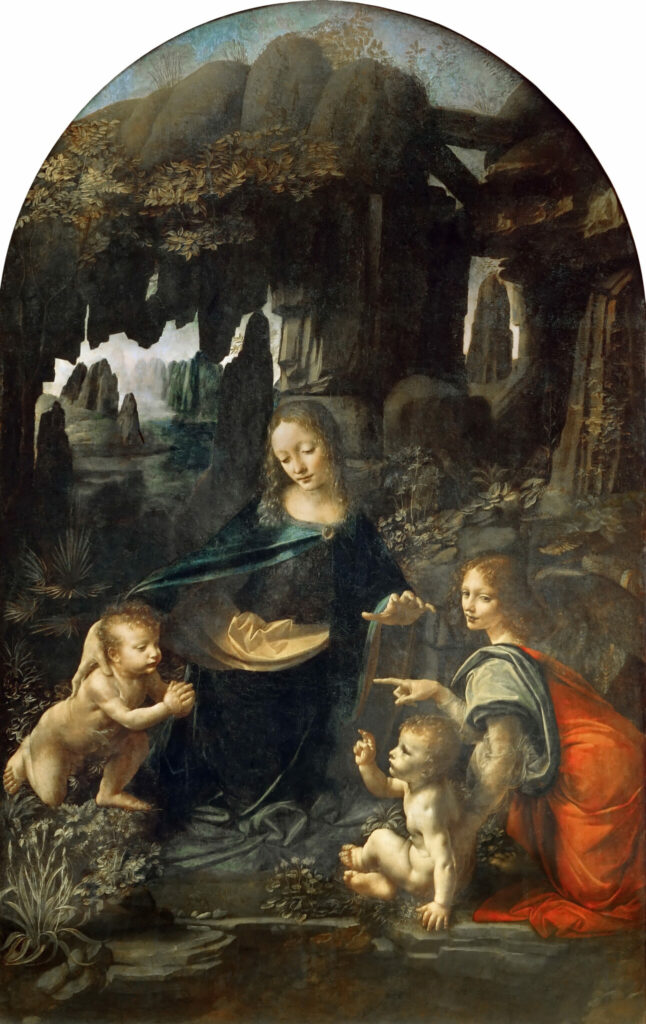
By Leonardo da Vinci – gallerix.ru, Public Domain, https://commons.wikimedia.org/w/index.php?curid=32430178
This painting marks da Vinci’s involvement with the Confraternity of the Immaculate Conception, which commissioned the work and is one of the most famous of da Vinci’s religious pieces alongside the Last Supper (which we’ll meet further down the list).
6. Head of a Woman (c.1500 -1510)
How would you feel if you went down in history for being… dishevelled? Well, ask da Vinci’s Head of a Woman as she’s been politely nicknamed ‘La scapigliata’ (translating to, you guessed it, ‘dishevelled’) by viewers.
Owing to her loose locks of hair and somewhat flustered look, this young woman is an excellent candid study of the human form, in stark opposition to the often posed, seated portraits of the time.
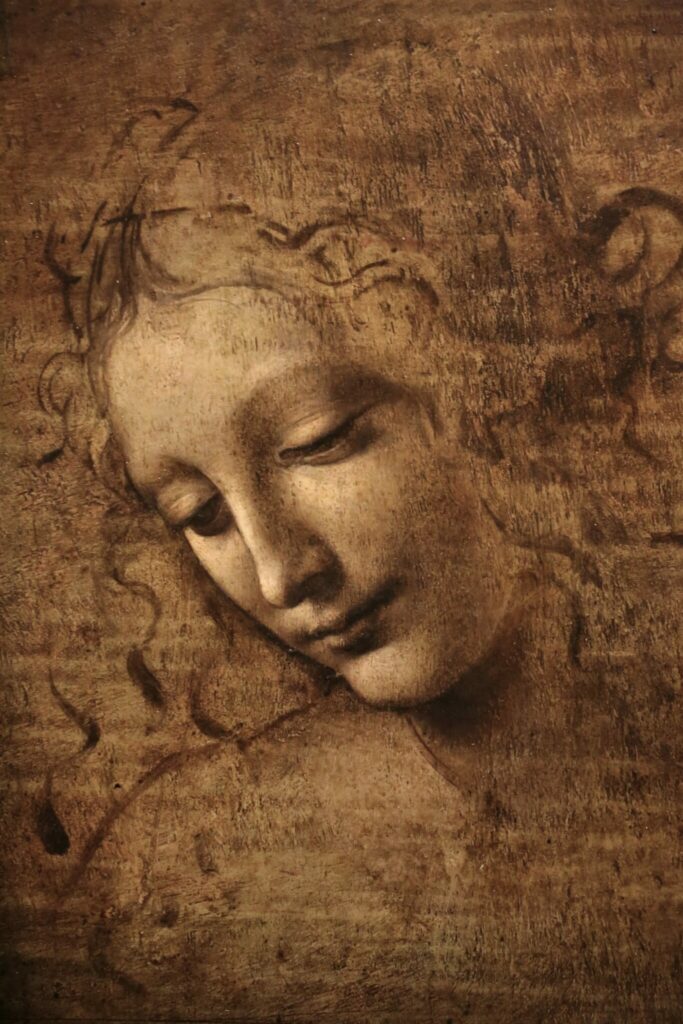
By Leonardo da Vinci – File:Leonardo da vinci, testa di fanciulla detta la scapigliata, 1500-10 ca., disegno su tavola, 02.jpg, Public Domain, https://commons.wikimedia.org/w/index.php?curid=91970475
What makes this piece so influential is not its subject or even the techniques used, but its unfinished nature. The porcelain skin of her face stands in direct contrast to the unfinished shoulders and bare backdrop, its artistic potential captivating painters for centuries by revealing da Vinci’s fluid, piecemeal method.
5. Lady with an Ermine (c. 1489–91)
At our halfway point, we meet one of da Vinci’s most luxurious ladies, the Lady with an Ermine. This unnamed woman has been identified by many art historians as Cecilia Gallerani who was the mistress of Leonardo’s patron, the Duke of Milan; however, we just can’t know for sure.

By Leonardo da Vinci – https://artsandculture.google.com/asset/lady-with-an-ermine/HwHUpggDy_HxNQ?hl=fr, Public Domain, https://commons.wikimedia.org/w/index.php?curid=90564951
Whoever she is, she has great taste and her elaborate garments, jewellery, and accessories make for great painting material. In a departure from some of his more demure works, this Lady demonstrates excellently da Vinci’s ability to paint detail — from the folds in her fabric sleeves to the fur on her fluffy companion.
(And, if you were as confused as we were when we first researched this painting, an ‘Ermine’ is a weasel. Cute!)
4. Self Portrait (c. 1490/1515–16)
Now we come to the man himself with da Vinci’s most famous ‘self-portrait’.
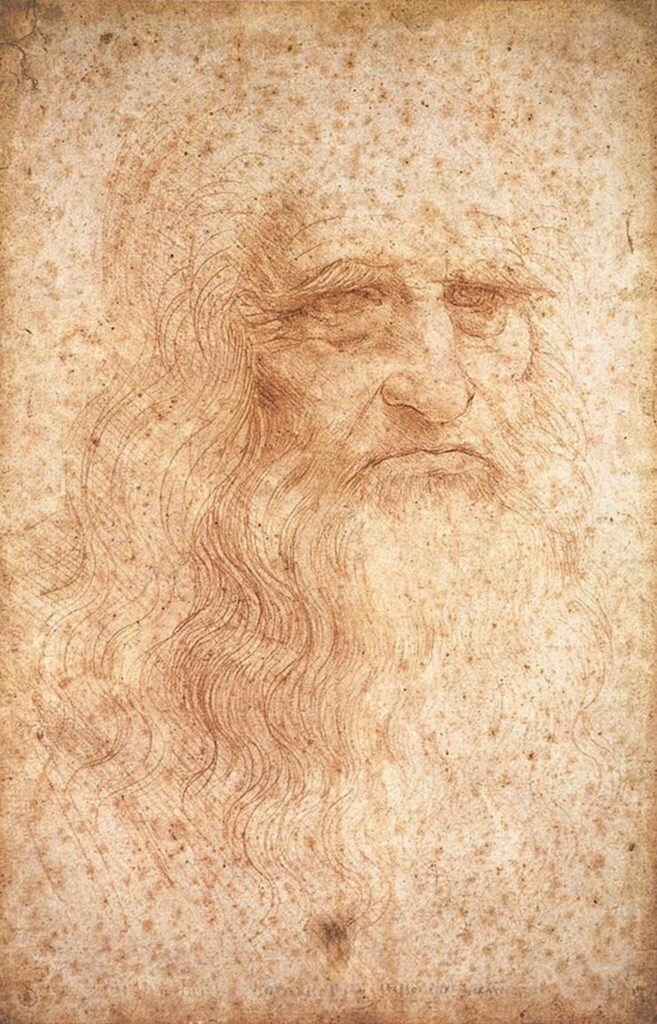
By Leonardo da Vinci – https://www.latitudinex.com/europa/leonardo-valle-della-loira-rinascimento.html Web Gallery of Art: Image Info about artwork, Public Domain, https://commons.wikimedia.org/w/index.php?curid=15497207
The dappled, splotched paper and scratchy red chalk lines come together to give us an image weathered by time, but an iconic one nonetheless. Largely regarded to be a self-portrait by art historians, the drawing of this elderly man with long hair and a rather impressive beard has been reproduced to such a degree that it’s now, for many, the defining image of da Vinci. That being said, some critics argue that this cannot be da Vinci simply because it looks too old and he died at the sprightly age of 67.
We’ll leave it up to you to decide.
3. The Vitruvian Man (c. 1490)
Third on the podium is the well-known Vitruvian Man or, as we like to call it, the poster child of the Renaissance. Many people know this image without even consciously ‘knowing it’ since it is so widespread in educational, cultural, artistic, and decorative contexts.
This pen-and-ink sketch comes from one of da Vinci’s many notebooks kept in his later years. What many people don’t know about this piece, however, is that it extends to more than just the sketch. Da Vinci paired this drawing with a series of notes explaining Roman architect, Vitruvius’s, ideas about ideal human proportions from way back in the 1st century BCE. We can all agree that this image was a long time in the making.
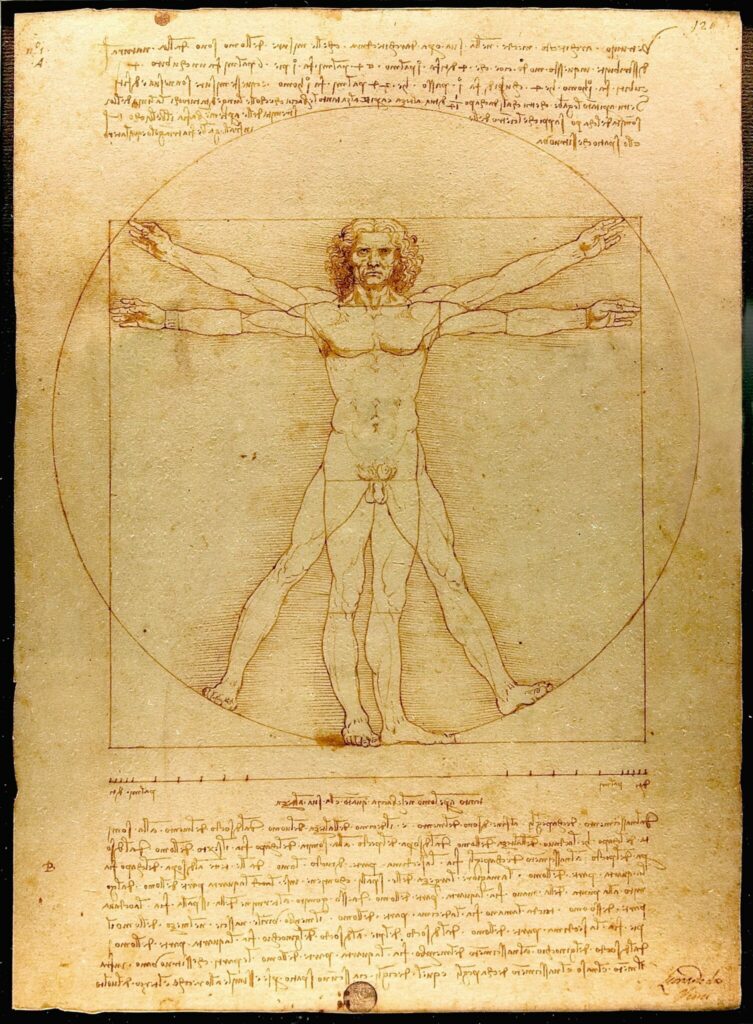
By Leonardo da Vinci – Vitruvian Man – Public Domain, https://commons.wikimedia.org/w/index.php?curid=2738140
Da Vinci brings Vitruvius’s theory — that the perfect human could fit inside both a circle and a square — to life with his male figure. In perfect proportion and symmetry, combining both art and science, da Vinci’s work is representative of the Renaissance itself, owing to its popularity.
Consumers have taken this image and run with it, turning the figure into fan art, memes, and detailed recreations. We can’t say da Vinci would be mad about it, he might appreciate feeling so relevant hundreds of years later!
2. The Last Supper (c. 1495–98)
Coming in at number two, we have the Last Supper, one of the most iconic mural paintings in the world.
This painting was commissioned by the Duke of Milan, Ludovico Sforza, who was da Vinci’s patron. Uniquely, the painting depicts a sequential narrative where several moments from the Gospels happen at once. A seminal moment in Christian Scripture — Jesus declares that one of his followers will betray him — da Vinci set himself quite the challenge with this one.

By Leonardo da Vinci – Unknown source, Public Domain, https://commons.wikimedia.org/w/index.php?curid=24759
Alongside the detailed humble supper and rolling hills in the background, da Vinci captures 12 reactions to Jesus’s statement: in posture, in facial expression, and in gesture, making this a very impressive visual feat of capturing the human condition.
1. The Mona Lisa (c. 1503–19)
Taking the top spot? The Mona Lisa of course. Probably the most famous piece of artwork in the world, da Vinci really outdid himself when he created our dear Mona. Thousands of tourists flock to the Louvre Museum every day to see this painting in the flesh, captivated by her mysterious gaze and that famous enigmatic smile.
For some viewers, a dark-toned painting of a woman in modest clothes might not seem worth the fuss. However, those more au fait with painting understand that the Mona Lisa is a triumph in realism. While it may seem simple, many sophisticated techniques were used by da Vinci at the time, including one called ‘sfumato’ which involves the blending of light and shadow.

By Leonardo da Vinci – Cropped and relevelled from File:Mona Lisa, by Leonardo da Vinci, from C2RMF.jpg. Originally C2RMF: Galerie de tableaux en très haute définition: image page, Public Domain, https://commons.wikimedia.org/w/index.php?curid=15442524
Regardless of whether you appreciate the brush strokes behind the artwork, though, you can’t deny being drawn to her mischievous smile. Today, she remains a figure at the very forefront of popular culture, being recreated again and again — be it playing the guitar, blowing her nose, or chewing bubble gum.
Get your own da Vinci
If you’re feeling inspired by da Vinci’s artwork, why not bring some of them into your home or workspace with Displate’s metal da Vinci posters? Or, dip your toe further into the art world with our impressive collection of assorted painting posters. From Monet (but with cats) to Van Gogh (yes, also available with cats), we’ve got it all!
